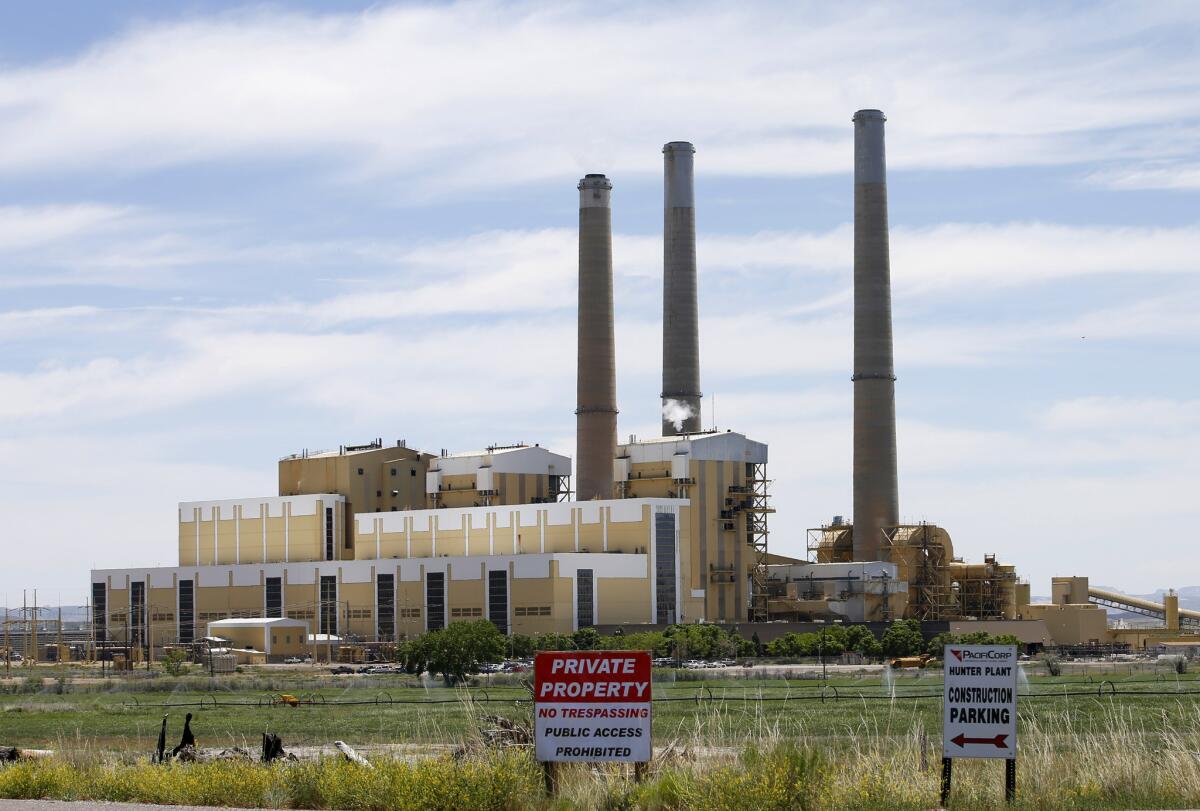State electric grid expansion would add coal-heavy utility

The manager of California’s electricity grid is chasing windmills in Wyoming as a way to help the state meet its clean-energy goals.
But some see the plan as a billionaire’s pipe dream, wondering: How will the California Independent System Operator achieve its goals by tapping an out-of-state company that produces 62% of its power from coal and 15% from natural gas?
The company, PacifiCorp., is a subsidiary of Nebraska investor Warren Buffett’s Berkshire Hathaway Energy. And it produces just a small fraction of the clean energy the state needs to reach its mandate of 50% renewable generation from sources such as wind and the sun by 2030.
“If not done with the right partners, a regional power market could increase greenhouse gas emissions and prop up out-of-state coal plants that threaten clean air and water across the region,” Sierra Club California Director Kathryn Phillips said in a statement opposing the PacifiCorp. proposal, which was announced a year ago and has gained momentum recently with a series of workshops across California.
Cal-ISO wants Portland, Ore.-based PacifiCorp. to hold the same status as California’s major investor-owned utilities: Southern California Edison, San Diego Gas & Electric and Pacific Gas & Electric. The inclusion of PacifiCorp. has been deemed an expansion of the western electric grid.
That would extend Cal-ISO’s role as a manager of electricity beyond just California’s borders into other western states, including Oregon, Washington, Wyoming, Utah and Idaho.
The new regional system operator would determine when power plants at the various utilities would operate to ensure the electric grid remains in balance. That is crucial because if too much electricity overloads the system, it can result in blackouts just as surely as when too few electrons are on the power grid.
Cal-ISO and PacifiCorp. promise lower electric rates from the deal. And even more notably, it would make it easier to manage all of the new clean energy that would need to be developed to meet California’s 50% mandate.
“To meet the 50% goal you have to build more stuff,” said Keith Casey, Cal-ISO’s vice president for market and infrastructure development. “It’s much more cost effective to rely on the regional market.”
Proponents of the western grid expansion are pressing California’s Legislature to back the plan, which some observers say could happen as early as the close of this year’s session.
PacifiCorp. owns 1,030 megawatts of wind power, which the company says places it second in the nation for utility-scale wind farms.
Cal-ISO says California needs to add enough wind and solar power facilities to equal almost 17 times the wind energy PacifiCorp. owns to meet the 50% mandate.
Casey and Bob Gravely, a PacifiCorp. spokesman, said consumers should not be alarmed by PacifiCorp.’s large portfolio of coal-fired power plants. Some of those plants are retiring and the additional renewable energy resources will mean more clean energy throughout all of the West.
Because all of the new solar and wind projects will generate more electricity than California needs, the regional market will allow the excess electricity to be shared with other states. And when the wind isn’t blowing in California, the state can tap the wind from such states as Wyoming.
“A regional grid is something we’re looking at developing for the long term,” Gravely said. “A lot’s going to change in the way energy is produced in the next 20-25 years.
“Across the region, as we go through the 2020s into the 2030s, the percentage of energy generated from renewables is going to increase,” he said. “The percentage generated by fossil fuels is going to decrease.”
The benefit to consumers, Casey and Gravely argue, is that the cost of the additions to the electric grid would be spread out among all members of the regional system, rather than just Californians.
Where new power plants and transmission lines benefit California consumers, the plan is to add those costs to those customers’ rates, Gravely said.
The concern is that the strategy may be more beneficial to utilities and large power generation companies than to consumers.
For instance, the California Solar Energy Industries Assn. contends that Cal-ISO underestimates how much electricity homeowners and businesses will generate by 2030 with their own solar panels.
Cal-ISO estimates that by 2030, consumer solar systems will total about 17,500 megawatts. The solar industry group calculates 17,500 megawatts to be the bottom of a range that could reach three times that amount based on current growth rates.
At the high end of that range, consumer-generated solar power would more than meet the renewable-electricity demand. But consumer-generated solar electricity is expected by state energy officials to make up just a tiny fraction of the 50% goal — so small that it virtually was excluded from the mandate.
Further complicating the proposal to include PacifiCorp. as a full participant in Cal-ISO is the question of who will run the new regional authority. And would the new governing body, which is appointed by California’s governor and approved by the state Senate, share the concerns about PacifiCorp.’s heavy coal and overall fossil fuel energy mix?
Other states want a board that includes representation from each area, which would dilute California’s control over Cal-ISO. Other states, Gravely said, want to ensure that the regional system operator meets all consumers’ electric needs, not just California’s.
State lawmakers, led by Senate leader Kevin de Leon, have raised concern about such a change.
Critics of PacifiCorp., such as the Sierra Club, say they worry that all of the talk of renewables is not consistent with the utility’s current and past operations.
“PacifiCorp has spent the last decade sinking $2 billion into its coal plants, fighting rooftop solar and trying to stop independent renewable energy developers,” said Bill Corcoran, a Western director of the Sierra Club. “Their clean energy talk is belied by their fossil fuels walk.”
“PacifiCorp,” Corcoran said, “needs to demonstrate clean energy leadership before it is allowed to integrate with the California grid.”
For more energy news, follow Ivan Penn on Twitter: @ivanlpenn







